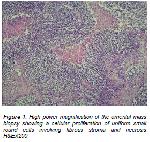 |
 |
| [ Ana Sayfa | Editörler | Danışma Kurulu | Dergi Hakkında | İçindekiler | Arşiv | Yayın Arama | Yazarlara Bilgi | E-Posta ] | |
| Fırat Tıp Dergisi | |||
| 2013, Cilt 18, Sayı 1, Sayfa(lar) 064-065 | |||
| [ Özet ] [ PDF ] [ Benzer Makaleler ] [ Yazara E-Posta ] [ Editöre E-Posta ] | |||
| A Rare Cause of Ascites: Desmoplastic Small Round Cell Tumour | |||
| Adnan TAS1, Mehmet ARHAN2, Sercan AKSOY3, Seyfettin KOKLU2 | |||
| 1Osmaniye Public Hospital, Gastroenterology, Osmaniye, Turkey 2Ankara Education and Research Hospital, Gastroenterology, Ankara, Turkey 3Ankara Numune Education and Research Hospital, Oncology, Ankara, Turkey |
|||
| Keywords: Ascites, Desmoplastic small round cell tumour, Young patient, Asit, Dezmoplastik küçük yuvarlak hücreli tümör, Genç hasta | |||
| Summary | |||
Desmoplastic small round cell tumour (DSRCT) is a malignant pathologic entity with a mesothelial origin. It is a rare neoplasm of small round cells located in the abdomen, mainly affecting male adolescents and young adults. Herein, we report a 17-year-old man presented with ascite and growing very fast abdominal mass. Laparoscopy was performed showing thickening of omentum and peritoneum and normal internal organs. Histopathological examination of the peritoneal samples concluded to desmoplastic small round cell tumor. The patient was treated according to the cyclophosphamide, vincristine and adriamisin. He responded chemotherapy and reduced intraabdominal, pelvic ascites and intraabdominal masses. |
|||
| Introduction | |||
Desmoplastic small round cell tumour (DSRCT) is a malignant pathologic entity with a mesothelial origin. It is a rare neoplasm of small round cells located in the abdomen, mainly affecting male adolescents and young adults. Microscopically, the morphologic prototype of the tumour shows nests of small, round cells embedded within a desmoplastic stroma, giving it its descriptive name as an entity. It is a highly malignant disease, with only 29% of patients surviving up to 3 years1. Herein, we report a case presented with ascid and growing very fast abdominal mass. A 17-year-old man was admitted to the gastroenterology department with a one month history of abdominal distention and discomfort, accompanied by a 10 kg weight loss. His past medical history was unre-markable. On physical examination, his abdomen was ditsended and tense with the presence of shifting dullness. Laboratory tests showed table. Ascite cytology was normal. Ultrasonography revealed massive ascites, thickening of mesentery and omental matting and multiple metastatic lesions in the liver. Upper gastrointestinal endoscopy and colonoscopy were all normal. Computerised tomography of the chest, abdomen and pelvis demonstrated extensive mediastinal and retroperitoneal adenopathy, diffuse omental masses and extensive pleural, intraabdominal and pelvic ascites and multiple metastatic lesions in the liver and lung. Laparoscopy demonitrated showing thickening of omentum and peritoneum and normal internal organs. Histopathological examination of the peritoneal samples concluded to desmoplastic small round cell tumor (Figure 1). The patients with metastases in the liver and lung treated according to the cyclophosphamide, vincristine and adriamisin as in our case. DSRCT is treated with therapy including 6 courses of multiagent chemotherapy. He responded chemotherapy and reduced intraabdominal, pelvic ascites and intraabdominal masses. He was discharged and was free of symtoms at the follow up.
DSRCT is a rare aggressive sarcoma that occurs predominantly in male adolescents or young adults2. Less than 200 cases have been reported3. Median age at diagnosis is 21 years. Most DSRCT first appear at the peritoneum in the abdomen and spread into multiple masses affecting the intraabdominal organs and extend posteriorly with metastases occurring in lungs, bone, or ganglia4. DSRCT is characterised by the formation of nests of small round cells surrounded by fibrous tissue. The most common diagnostic tool is the CT scan. This shows a characteristic pattern of multiple intraabdominal masses without apparent relationship to the primary organ. An open biopsy is needed for an accurate diagnosis so that the pattern of the cellular nests can be seen. Laparoscopy has also recently been used for biopsy of these tumours1. Immunohistological studies were focally positive for desmin and diffuse positive for vimentin. CD 99 with cytoplasmic immunoreactivity and negative for myogenin, CD20, CD45RO, CD99, SMA, S100, PAS, WT-1, CK20, pankeratin, NSE, LCA and chromogranin. Among causes of ascites in a young man are present sclerosing epithelioid fibrosarcoma, hemophagocytic lymphohistiocytosis and mucinous cystadenoma of the peritoneum5,6. Treatment should begin with chemotherapy according to various protocols, followed by surgery to resect all or most of the tumour. Kurre et al. have described three cases treated with radiotherapy with good results4. Finally, peripheral blood stem transplantation is another option. In conclusion DSCRT is an exremely rare tumor and should be among the differential diagnosis of ascites in a young patient. |
|||
| References | |||
1) Quaglia MP, Brennan MF. The clinical approach to desmoplastic small round cell tumor. Surg Oncol 2000; 9: 77-81.
2) Hayes-Jordan A, Anderson PM. The diagnosis and management of desmoplastic small round cell tumor: a review. Curr Opin Oncol 2011; 23: 385-9.
3) Jordan AH, Pappo A. Management of desmoplastic small round-cell tumors in children and young adults. J Pediatr Hematol Oncol 2012; 2: 73-5.
4) Roganovich J, Bisogno G, Cecchetto G, D'Amore ES, Carli M. Paratesticular desmoplastic small round cell tumor: case report and review of the literature. J Surg Oncol 1999; 71: 269-72.
|
|||
| [ Başa Dön ] [ Özet ] [ PDF ] [ Benzer Makaleler ] [ Yazara E-Posta ] [ Editöre E-Posta ] | |||
| [ Ana Sayfa | Editörler | Danışma Kurulu | Dergi Hakkında | İçindekiler | Arşiv | Yayın Arama | Yazarlara Bilgi | E-Posta ] |
